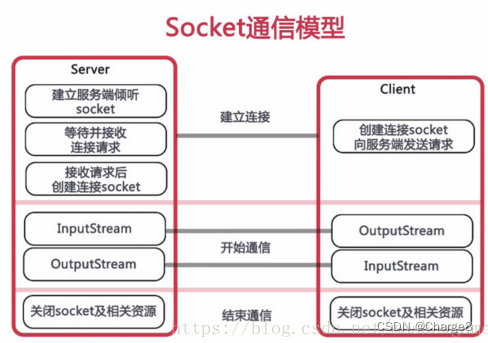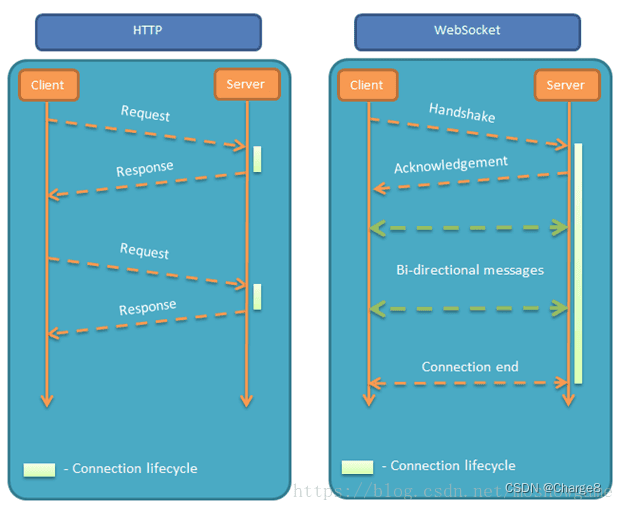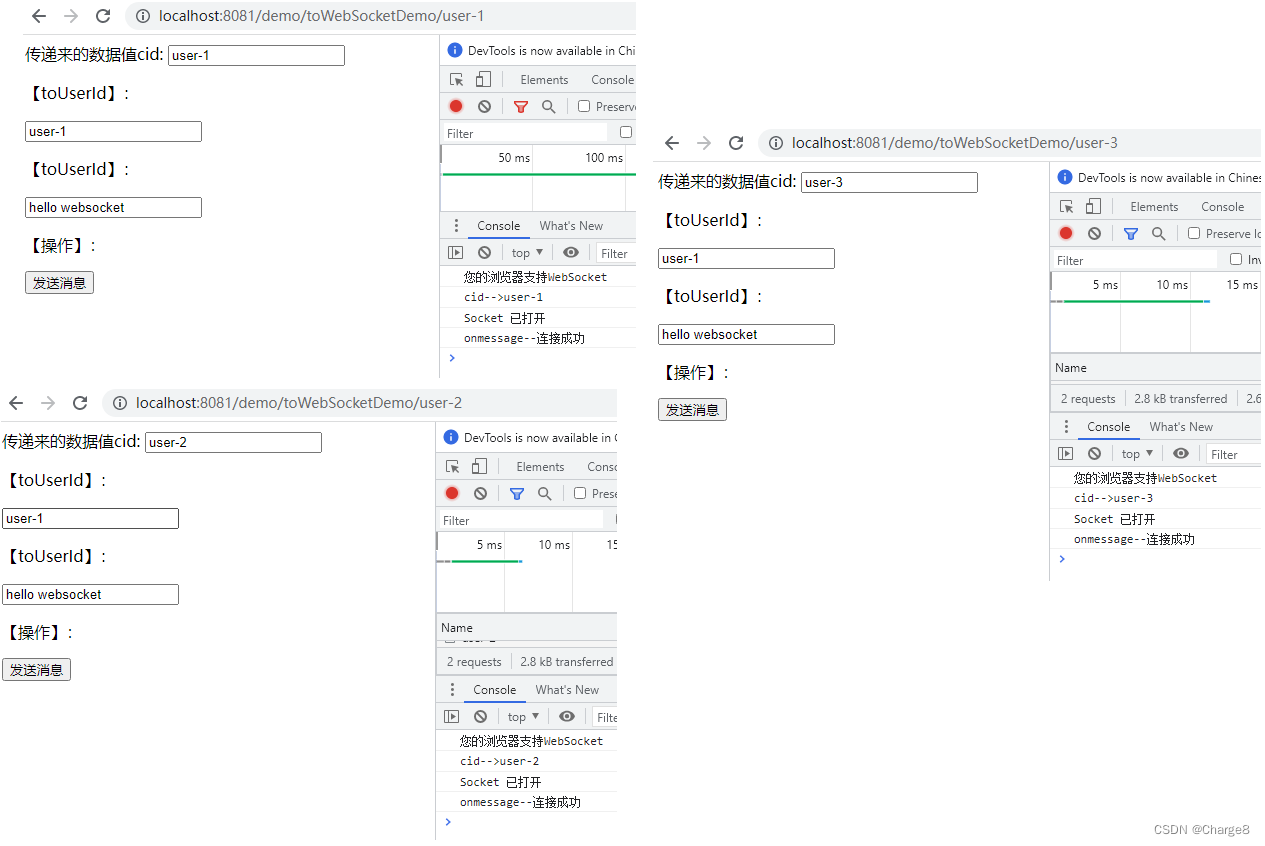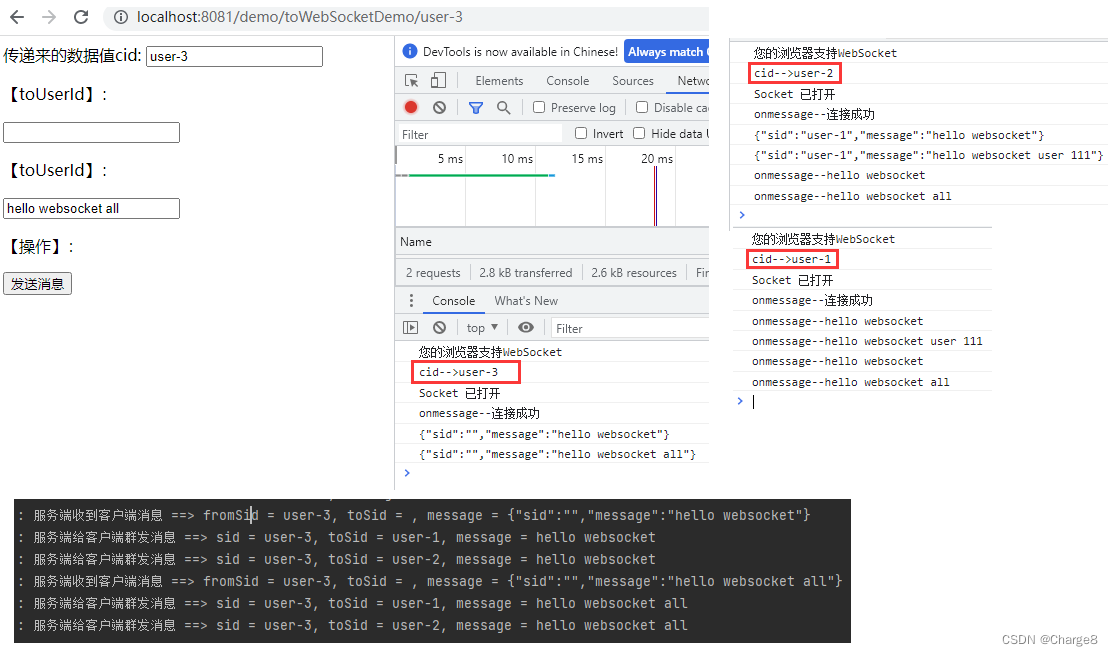- 1【OpenCV】第十九章: 视频操作入门_cv::videocapture
- 2Android源码下载网址
- 3用批处理命令打开控制面板选项_批处理打开控制面板
- 4获取linux内存、cpu、磁盘IO等信息脚本及其原理详解_shell 脚本 cpu 取平均值
- 5anaconda目录下的pkgs文件夹很大,可以删除吗?_anaconda pkgs
- 6Yolov5、yolov7、yolov8训练自己的数据集(不用配环境,只需3步就能训练自己的数据集)_yolov7 百度网盘
- 7sklearn.metrics 中多分类问题指标的计算函数使用_y_score怎么计算
- 8oracleshell执行新医保数据转换后台_oracle 医保
- 9GPT2原理_gpt2基础原理
- 10【SPIE独立出版 | Ei检索 】第二届物联网与机器学习国际学术会议征稿中!_spie会议论文集影响因子
SpringBoot 集成WebSocket详解_springboot websocket
赞
踩
感谢参考文章的博主,关于WebSocket概述和使用写的都很详细,这里结合自己的理解,整理了一下。
一、WebSocket概述
1、WebSocket简介
WebSocket协议是基于TCP的一种新的网络协议。它实现了浏览器与服务器全双工(full-duplex)通信——允许服务器主动发送信息给客户端。
图来自参考文章:

2、为什么需要WebSocket
HTTP 是基于请求响应式的,即通信只能由客户端发起,服务端做出响应,无状态,无连接。
- 无状态:每次连接只处理一个请求,请求结束后断开连接。
- 无连接:对于事务处理没有记忆能力,服务器不知道客户端是什么状态。
通过HTTP实现即时通讯,只能是页面轮询向服务器发出请求,服务器返回查询结果。轮询的效率低,非常浪费资源,因为必须不停连接,或者 HTTP 连接始终打开。
WebSocket的最大特点就是,服务器可以主动向客户端推送信息,客户端也可以主动向服务器发送信息,是真正的双向平等对话。
WebSocket特点:
- (1)建立在 TCP 协议之上,服务器端的实现比较容易。
- (2)与 HTTP 协议有着良好的兼容性。默认端口也是80和443,并且握手阶段采用 HTTP 协议,因此握手时不容易屏蔽,能通过各种 HTTP 代理服务器。
- (3)数据格式比较轻量,性能开销小,通信高效。
- (4)可以发送文本,也可以发送二进制数据。
- (5)没有同源限制,客户端可以与任意服务器通信。
- (6)协议标识符是ws(如果加密,则为wss),服务器网址就是 URL。
图来自参考文章:

二、SpringBoot整合WebSocket
创建 SpringBoot项目,引入 WebSocket依赖,前端这里比较简陋。
<!-- websocket dependency -->
<dependency>
<groupId>org.springframework.boot</groupId>
<artifactId>spring-boot-starter-websocket</artifactId>
<version>2.7.12</version>
</dependency>
<dependency>
<groupId>org.springframework.boot</groupId>
<artifactId>spring-boot-starter-thymeleaf</artifactId>
<version>2.7.12</version>
</dependency>
- 1
- 2
- 3
- 4
- 5
- 6
- 7
- 8
- 9
- 10
- 11
- 12
application.yml:
server:
port: 8081
spring:
thymeleaf:
mode: HTML
cache: true
prefix: classpath:/templates/
encoding: UTF-8
suffix: .html
check-template-location: true
template-resolver-order: 1
- 1
- 2
- 3
- 4
- 5
- 6
- 7
- 8
- 9
- 10
- 11
- 12
1、WebSocketConfig
启用 WebSocket的支持也是很简单。
/** * WebSocket配置类。开启WebSocket的支持 */ @Configuration public class WebSocketConfig { /** * bean注册:会自动扫描带有@ServerEndpoint注解声明的Websocket Endpoint(端点),注册成为Websocket bean。 * 要注意,如果项目使用外置的servlet容器,而不是直接使用springboot内置容器的话,就不要注入ServerEndpointExporter,因为它将由容器自己提供和管理。 */ @Bean public ServerEndpointExporter serverEndpointExporter() { return new ServerEndpointExporter(); } }
- 1
- 2
- 3
- 4
- 5
- 6
- 7
- 8
- 9
- 10
- 11
- 12
- 13
- 14
- 15
- 16
2、WebSocketServer
这里就是重点了,核心都在这里。
- 因为WebSocket是类似客户端服务端的形式(
采用ws协议),那么这里的WebSocketServer其实就相当于一个ws协议的Controller 直接@ServerEndpoint("/imserver/{userId}") 、@Component启用即可,然后在里面实现@OnOpen开启连接,@onClose关闭连接,@onMessage接收消息等方法。- 新建一个
ConcurrentHashMap用于接收当前userId的WebSocket或者Session信息,方便IM之间对userId进行推送消息。单机版实现到这里就可以。 - 集群版(多个ws节点)还需要借助 MySQL或者 Redis等进行订阅广播方式处理,改造对应的 sendMessage方法即可。
/** * WebSocket的操作类 */ @Component @Slf4j /** * html页面与之关联的接口 * var reqUrl = "http://localhost:8081/websocket/" + cid; * socket = new WebSocket(reqUrl.replace("http", "ws")); */ @ServerEndpoint("/websocket/{sid}") public class WebSocketServer { /** * 静态变量,用来记录当前在线连接数,线程安全的类。 */ private static AtomicInteger onlineSessionClientCount = new AtomicInteger(0); /** * 存放所有在线的客户端 */ private static Map<String, Session> onlineSessionClientMap = new ConcurrentHashMap<>(); /** * 连接sid和连接会话 */ private String sid; private Session session; /** * 连接建立成功调用的方法。由前端<code>new WebSocket</code>触发 * * @param sid 每次页面建立连接时传入到服务端的id,比如用户id等。可以自定义。 * @param session 与某个客户端的连接会话,需要通过它来给客户端发送消息 */ @OnOpen public void onOpen(@PathParam("sid") String sid, Session session) { /** * session.getId():当前session会话会自动生成一个id,从0开始累加的。 */ log.info("连接建立中 ==> session_id = {}, sid = {}", session.getId(), sid); //加入 Map中。将页面的sid和session绑定或者session.getId()与session //onlineSessionIdClientMap.put(session.getId(), session); onlineSessionClientMap.put(sid, session); //在线数加1 onlineSessionClientCount.incrementAndGet(); this.sid = sid; this.session = session; sendToOne(sid, "连接成功"); log.info("连接建立成功,当前在线数为:{} ==> 开始监听新连接:session_id = {}, sid = {},。", onlineSessionClientCount, session.getId(), sid); } /** * 连接关闭调用的方法。由前端<code>socket.close()</code>触发 * * @param sid * @param session */ @OnClose public void onClose(@PathParam("sid") String sid, Session session) { //onlineSessionIdClientMap.remove(session.getId()); // 从 Map中移除 onlineSessionClientMap.remove(sid); //在线数减1 onlineSessionClientCount.decrementAndGet(); log.info("连接关闭成功,当前在线数为:{} ==> 关闭该连接信息:session_id = {}, sid = {},。", onlineSessionClientCount, session.getId(), sid); } /** * 收到客户端消息后调用的方法。由前端<code>socket.send</code>触发 * * 当服务端执行toSession.getAsyncRemote().sendText(xxx)后,前端的socket.onmessage得到监听。 * * @param message * @param session */ @OnMessage public void onMessage(String message, Session session) { /** * html界面传递来得数据格式,可以自定义. * {"sid":"user-1","message":"hello websocket"} */ JSONObject jsonObject = JSON.parseObject(message); String toSid = jsonObject.getString("sid"); String msg = jsonObject.getString("message"); log.info("服务端收到客户端消息 ==> fromSid = {}, toSid = {}, message = {}", sid, toSid, message); /** * 模拟约定:如果未指定sid信息,则群发,否则就单独发送 */ if (toSid == null || toSid == "" || "".equalsIgnoreCase(toSid)) { sendToAll(msg); } else { sendToOne(toSid, msg); } } /** * 发生错误调用的方法 * * @param session * @param error */ @OnError public void onError(Session session, Throwable error) { log.error("WebSocket发生错误,错误信息为:" + error.getMessage()); error.printStackTrace(); } /** * 群发消息 * * @param message 消息 */ private void sendToAll(String message) { // 遍历在线map集合 onlineSessionClientMap.forEach((onlineSid, toSession) -> { // 排除掉自己 if (!sid.equalsIgnoreCase(onlineSid)) { log.info("服务端给客户端群发消息 ==> sid = {}, toSid = {}, message = {}", sid, onlineSid, message); toSession.getAsyncRemote().sendText(message); } }); } /** * 指定发送消息 * * @param toSid * @param message */ private void sendToOne(String toSid, String message) { // 通过sid查询map中是否存在 Session toSession = onlineSessionClientMap.get(toSid); if (toSession == null) { log.error("服务端给客户端发送消息 ==> toSid = {} 不存在, message = {}", toSid, message); return; } // 异步发送 log.info("服务端给客户端发送消息 ==> toSid = {}, message = {}", toSid, message); toSession.getAsyncRemote().sendText(message); /* // 同步发送 try { toSession.getBasicRemote().sendText(message); } catch (IOException e) { log.error("发送消息失败,WebSocket IO异常"); e.printStackTrace(); }*/ } }
- 1
- 2
- 3
- 4
- 5
- 6
- 7
- 8
- 9
- 10
- 11
- 12
- 13
- 14
- 15
- 16
- 17
- 18
- 19
- 20
- 21
- 22
- 23
- 24
- 25
- 26
- 27
- 28
- 29
- 30
- 31
- 32
- 33
- 34
- 35
- 36
- 37
- 38
- 39
- 40
- 41
- 42
- 43
- 44
- 45
- 46
- 47
- 48
- 49
- 50
- 51
- 52
- 53
- 54
- 55
- 56
- 57
- 58
- 59
- 60
- 61
- 62
- 63
- 64
- 65
- 66
- 67
- 68
- 69
- 70
- 71
- 72
- 73
- 74
- 75
- 76
- 77
- 78
- 79
- 80
- 81
- 82
- 83
- 84
- 85
- 86
- 87
- 88
- 89
- 90
- 91
- 92
- 93
- 94
- 95
- 96
- 97
- 98
- 99
- 100
- 101
- 102
- 103
- 104
- 105
- 106
- 107
- 108
- 109
- 110
- 111
- 112
- 113
- 114
- 115
- 116
- 117
- 118
- 119
- 120
- 121
- 122
- 123
- 124
- 125
- 126
- 127
- 128
- 129
- 130
- 131
- 132
- 133
- 134
- 135
- 136
- 137
- 138
- 139
- 140
- 141
- 142
- 143
- 144
- 145
- 146
- 147
- 148
- 149
- 150
- 151
- 152
- 153
3、controller
controller中只有一个简单的界面跳转操作,其他的不需要。
@Controller @RequestMapping("/demo") public class DemoController { /** * 跳转到websocketDemo.html页面,携带自定义的cid信息。 * http://localhost:8081/demo/toWebSocketDemo/user-1 * * @param cid * @param model * @return */ @GetMapping("/toWebSocketDemo/{cid}") public String toWebSocketDemo(@PathVariable String cid, Model model) { model.addAttribute("cid", cid); return "websocketDemo"; } }
- 1
- 2
- 3
- 4
- 5
- 6
- 7
- 8
- 9
- 10
- 11
- 12
- 13
- 14
- 15
- 16
- 17
- 18
- 19
4、websocketDemo.html
新建一个文件,放到 templates目录下面。页面简单使用js代码调用WebSocket。
<!DOCTYPE html> <html xmlns:th="http://www.thymeleaf.org"> <head> <meta charset="UTF-8"> <title>666666</title> </head> <body> 传递来的数据值cid: <input type="text" th:value="${cid}" id="cid"/> <p>【toUserId】: <div><input id="toUserId" name="toUserId" type="text" value="user-1"></div> <p>【toUserId】: <div><input id="contentText" name="contentText" type="text" value="hello websocket"></div> <p>【操作】: <div> <button type="button" onclick="sendMessage()">发送消息</button> </div> </body> <script type="text/javascript"> var socket; if (typeof (WebSocket) == "undefined") { console.log("您的浏览器不支持WebSocket"); } else { console.log("您的浏览器支持WebSocket"); //实现化WebSocket对象,指定要连接的服务器地址与端口 建立连接 var cid = document.getElementById("cid").value; console.log("cid-->" + cid); var reqUrl = "http://localhost:8081/websocket/" + cid; socket = new WebSocket(reqUrl.replace("http", "ws")); //打开事件 socket.onopen = function () { console.log("Socket 已打开"); //socket.send("这是来自客户端的消息" + location.href + new Date()); }; //获得消息事件 socket.onmessage = function (msg) { console.log("onmessage--" + msg.data); //发现消息进入 开始处理前端触发逻辑 }; //关闭事件 socket.onclose = function () { console.log("Socket已关闭"); }; //发生了错误事件 socket.onerror = function () { alert("Socket发生了错误"); //此时可以尝试刷新页面 } //离开页面时,关闭socket //jquery1.8中已经被废弃,3.0中已经移除 // $(window).unload(function(){ // socket.close(); //}); } function sendMessage() { if (typeof (WebSocket) == "undefined") { console.log("您的浏览器不支持WebSocket"); } else { // console.log("您的浏览器支持WebSocket"); var toUserId = document.getElementById('toUserId').value; var contentText = document.getElementById('contentText').value; var msg = '{"sid":"' + toUserId + '","message":"' + contentText + '"}'; console.log(msg); socket.send(msg); } } </script> </html>
- 1
- 2
- 3
- 4
- 5
- 6
- 7
- 8
- 9
- 10
- 11
- 12
- 13
- 14
- 15
- 16
- 17
- 18
- 19
- 20
- 21
- 22
- 23
- 24
- 25
- 26
- 27
- 28
- 29
- 30
- 31
- 32
- 33
- 34
- 35
- 36
- 37
- 38
- 39
- 40
- 41
- 42
- 43
- 44
- 45
- 46
- 47
- 48
- 49
- 50
- 51
- 52
- 53
- 54
- 55
- 56
- 57
- 58
- 59
- 60
- 61
- 62
- 63
- 64
- 65
- 66
- 67
- 68
- 69
- 70
- 71
- 72
- 73
5、测试运行效果
(1)访问页面,建立连接
启动项目,访问 http://localhost:8081/demo/toWebSocketDemo/{cid} 跳转到页面,然后就可以和WebSocket交互了。
这里开启三个浏览器的窗口:
http://localhost:8081/demo/toWebSocketDemo/user-1
http://localhost:8081/demo/toWebSocketDemo/user-2
http://localhost:8081/demo/toWebSocketDemo/user-3
- 1
- 2
- 3
然后打开浏览器的控制台。此时idea控制台中的输出信息如下所示。说明连接建立成功。


(2)指定sid发送消息
user-2给 user-1发送数据,也可以自己给自己发送数据。
指定的窗口能够收到数据,其他窗口收不到数据。

(3)群发送消息
user-3群发送数据。
在代码中定义群发的条件为:当不指定 toUserid时,则为群发。

你学会了嘛。
参考文章:
- SpringBoot2.0集成WebSocket,实现后台向前端推送信息:https://blog.csdn.net/moshowgame/article/details/80275084
- SpringBoot整合WebSocket(session共享实现):https://blog.csdn.net/printf88/article/details/123685995
– 求知若饥,虚心若愚。



